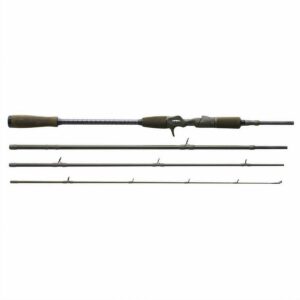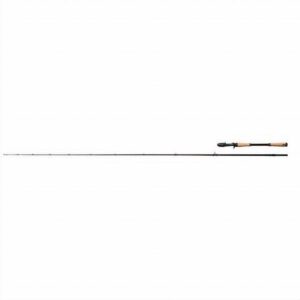Baitcasting Rods
Baitcasting rods are a popular fishing rod type that provide anglers with a level of accuracy, power, and control that is difficult to achieve with other rod types. Baitcasting rods are designed to accommodate the use of a baitcasting reel, which allows the angler to cast their bait or lure with greater accuracy and precision, making it a favorite of experienced anglers. In this article, we will explore the different types of baitcasting rods, how to select the right one for your needs, and how to use it to improve your fishing success.
Types of Baitcasting Rods
There are two main types of baitcasting rods: casting and flipping rods. Casting rods are designed for long, accurate casts and are typically used for fishing in large open bodies of water. They are also suitable for targeting larger fish, as they offer plenty of power and control. Casting rods are generally longer than flipping rods and come with varying actions that make them versatile for different fishing conditions.
Flipping rods, on the other hand, are shorter and stiffer than casting rods. They are designed for shorter casts and are excellent for flipping and pitching techniques. These techniques require accurate placement of your bait or lure, which is an area where flipping rods excel. They are also used for fishing in shallow water and around cover, where precise casting is essential.
Baitcasting Rod Lengths
Baitcasting rods come in varying lengths from 5 to 8 feet long. The length of your baitcasting rod will depend on the type of fishing you plan to do. Longer rods are generally used for casting, as they provide more distance and accuracy, making them well-suited for larger bodies of water. Shorter rods are better suited for close-quarters fishing, such as fishing in rivers, streams, and narrow channels.
Baitcasting Rod Power and Action
The power of your baitcasting rod is determined by the size and strength of the fish you plan to catch. Rod power is rated on a scale from ultra-light to ultra-heavy. Lighter rods are typically used for smaller fish species, while heavier rods are suitable for larger game fish.
The action of your baitcasting rod refers to its bending and flexing characteristics. The three main types of rod action are fast, medium, and slow. A fast-action baitcasting rod is stiff at the tip and is suitable for high-speed, long-distance casting. A medium-action baitcasting rod has a more gradual taper and provides a good balance of power and flexibility, making it versatile for different fishing techniques. A slow-action baitcasting rod bends throughout the length of the rod, making it ideal for fishing smaller fish that require a more delicate touch.
Baitcasting Rod Materials
Baitcasting rods can be made from various materials such as graphite, fiberglass, and composite. Graphite rods are lightweight, sensitive, and offer excellent sensitivity and responsiveness. Fiberglass rods, on the other hand, are heavier and more durable, making them well-suited for larger fish species. Composite rods are a hybrid of graphite and fiberglass, offering the best of both worlds by providing sensitivity, durability, and power in one package.
How to Select the Right Baitcasting Rod
When selecting a baitcasting rod, there are several factors you should consider to ensure you choose the right one for your needs. These factors include:
1. Fishing Conditions – The fishing conditions you plan to fish in will play a significant role in the type of baitcasting rod you select. Consider the size of the body of water you plan to fish in, the species of fish you plan to target, and whether you plan to fish around cover or in open water.
2. Rod Length – Rod length will depend on your fishing technique and the size of the body of water you plan to fish in. Longer rods are suitable for casting, while shorter rods are better suited for flipping and pitching techniques.
3. Power and Action- Power and action will depend on the size and strength of the fish you plan to catch and the type of fishing technique you plan to use.
4. Material – Choose a material that suits your fishing needs and budget.
5. Brand – Choose a well-known and reputable brand to ensure you get a quality baitcasting rod that will last for years.
How to Use a Baitcasting Rod
Using a baitcasting rod requires a bit of practice and patience. Here are some tips on how to use a baitcasting rod:
1. Set Your Drag – Adjust the drag on your reel based on the size of your fishing line and the species of fish you plan to catch.
2. Adjust Your Brake – Set the brake on your baitcasting reel to prevent backlash and ensure smooth casting.
3. Cast Your Line – Face your rod in the direction of your target, hold your baitcasting rod with both hands, and raise it to a 2 o’clock position. Push the button on your reel to release your line, and cast your bait or lure towards your target.
4. Reel In Your Catch – Slowly reel in your catch, keeping your line tight and your rod tip up to prevent fish from escaping.
In conclusion, a baitcasting rod is a versatile and powerful tool that offers a high level of accuracy, power, and control when used correctly. By selecting the right baitcasting rod for your needs and practicing proper casting techniques, you can improve your fishing success and enjoy the thrill of catching big game fish.
-

Savage Gear SG4 Medium Game Trigger 7′ 213cm 10-30g 2Sec
£123.99 -

Savage Gear SG4 Fast Game BC Travel 7’3″ 30-80g 4pc
£120.99 -

Savage Gear Revenge SG6 Pela Cast 7’3″ 20-80g 1+1
£172.99 -

Savage Gear Alpha SG6 Pelagic Casting Rod 7’6″ 40-140g 1+1
£198.99 -

Berkley Lightning HT II Casting Rods
£45.99 – £60.99 -

Abu Garcia Spike S Crankbait 722 10-30g Casting Rod
£87.99 -

Abu Garcia Orra Casting Rods
£53.99 -

Abu Garcia Mörrum Travel Casting Rods
£291.99 -

Westin W6 Powercast-T Rod 7’9″ 40-130g 2sec
£260.99 -

Westin W6 Powercast Rod 7’9″ 40-130g 2sec
£260.99 -

Westin W6 Jerkbait-T Rod 6’6″ 40-130g 1+1sec
£242.99 -

Westin W6 Finesse TC Rods
£233.99 – £242.99
Baitcasting rods are a popular fishing rod type that provide anglers with a level of accuracy, power, and control that is difficult to achieve with other rod types. Baitcasting rods are designed to accommodate the use of a baitcasting reel, which allows the angler to cast their bait or lure with greater accuracy and precision, making it a favorite of experienced anglers. In this article, we will explore the different types of baitcasting rods, how to select the right one for your needs, and how to use it to improve your fishing success.
Types of Baitcasting Rods
There are two main types of baitcasting rods: casting and flipping rods. Casting rods are designed for long, accurate casts and are typically used for fishing in large open bodies of water. They are also suitable for targeting larger fish, as they offer plenty of power and control. Casting rods are generally longer than flipping rods and come with varying actions that make them versatile for different fishing conditions.
Flipping rods, on the other hand, are shorter and stiffer than casting rods. They are designed for shorter casts and are excellent for flipping and pitching techniques. These techniques require accurate placement of your bait or lure, which is an area where flipping rods excel. They are also used for fishing in shallow water and around cover, where precise casting is essential.
Baitcasting Rod Lengths
Baitcasting rods come in varying lengths from 5 to 8 feet long. The length of your baitcasting rod will depend on the type of fishing you plan to do. Longer rods are generally used for casting, as they provide more distance and accuracy, making them well-suited for larger bodies of water. Shorter rods are better suited for close-quarters fishing, such as fishing in rivers, streams, and narrow channels.
Baitcasting Rod Power and Action
The power of your baitcasting rod is determined by the size and strength of the fish you plan to catch. Rod power is rated on a scale from ultra-light to ultra-heavy. Lighter rods are typically used for smaller fish species, while heavier rods are suitable for larger game fish.
The action of your baitcasting rod refers to its bending and flexing characteristics. The three main types of rod action are fast, medium, and slow. A fast-action baitcasting rod is stiff at the tip and is suitable for high-speed, long-distance casting. A medium-action baitcasting rod has a more gradual taper and provides a good balance of power and flexibility, making it versatile for different fishing techniques. A slow-action baitcasting rod bends throughout the length of the rod, making it ideal for fishing smaller fish that require a more delicate touch.
Baitcasting Rod Materials
Baitcasting rods can be made from various materials such as graphite, fiberglass, and composite. Graphite rods are lightweight, sensitive, and offer excellent sensitivity and responsiveness. Fiberglass rods, on the other hand, are heavier and more durable, making them well-suited for larger fish species. Composite rods are a hybrid of graphite and fiberglass, offering the best of both worlds by providing sensitivity, durability, and power in one package.
How to Select the Right Baitcasting Rod
When selecting a baitcasting rod, there are several factors you should consider to ensure you choose the right one for your needs. These factors include:
1. Fishing Conditions – The fishing conditions you plan to fish in will play a significant role in the type of baitcasting rod you select. Consider the size of the body of water you plan to fish in, the species of fish you plan to target, and whether you plan to fish around cover or in open water.
2. Rod Length – Rod length will depend on your fishing technique and the size of the body of water you plan to fish in. Longer rods are suitable for casting, while shorter rods are better suited for flipping and pitching techniques.
3. Power and Action- Power and action will depend on the size and strength of the fish you plan to catch and the type of fishing technique you plan to use.
4. Material – Choose a material that suits your fishing needs and budget.
5. Brand – Choose a well-known and reputable brand to ensure you get a quality baitcasting rod that will last for years.
How to Use a Baitcasting Rod
Using a baitcasting rod requires a bit of practice and patience. Here are some tips on how to use a baitcasting rod:
1. Set Your Drag – Adjust the drag on your reel based on the size of your fishing line and the species of fish you plan to catch.
2. Adjust Your Brake – Set the brake on your baitcasting reel to prevent backlash and ensure smooth casting.
3. Cast Your Line – Face your rod in the direction of your target, hold your baitcasting rod with both hands, and raise it to a 2 o’clock position. Push the button on your reel to release your line, and cast your bait or lure towards your target.
4. Reel In Your Catch – Slowly reel in your catch, keeping your line tight and your rod tip up to prevent fish from escaping.
In conclusion, a baitcasting rod is a versatile and powerful tool that offers a high level of accuracy, power, and control when used correctly. By selecting the right baitcasting rod for your needs and practicing proper casting techniques, you can improve your fishing success and enjoy the thrill of catching big game fish.
100% Original product that covered warranty by the vendor.
You have the right to return your orders within 30 days.
Your orders are shipped seamlessly between countries.
Your payments are secure with our private security network.
